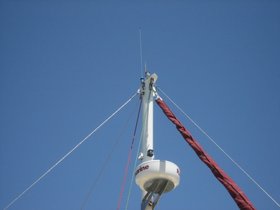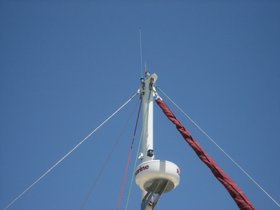So, refresh my memory. When and why should one select low or high power on one's VHF.
Other than the aforementioned channels that automatically select low power we use high power for everything. Never had a problem, never had a complaint.
So, refresh my memory. When and why should one select low or high power on one's VHF.
So, refresh my memory. When and why should one select low or high power on one's VHF.
.......... Two "properly functioning" VHF marine radios, on the same frequency, volume level turned up, and within close proximity, line of sight of each other, will hear each other at either low or high power settings.
David, I don't think there are any hard and fast rules, but I use low power for anyone within site and harbor communications.
When communicating with another boat, a Harbor Master, bridge tender, marina, repair yard, at close range line of sight of about one mile or less, use low power setting. Lower transmitter power will reduce the propagation distances, allowing more users to use the channel without interfering with each other.
Larry B.
-----------------------------------
When communicating with another boat, a Harbor Master, bridge tender, marina, repair yard, at close range line of sight of about one mile or less, use low power setting. Lower transmitter power will reduce the propagation distances, allowing more users to use the channel without interfering with each other.
Larry B.
That's been my practice as well.
Okay. That's what I was trying to remember.

----------------------------------------------------
The issue of folding the antennae down to horizontal will affect the overall range of the radio at distance, because the marine antennae are usually 3 to 6 db gain. (kind of like the way the light from a lighthouse is focused and projected across the water.) Tip the lighthouse on its side and most of the light goes where???
But it should still work good enough for short range, line of sight, communications, unless the antennae or coax are shorting out.
Larry B.
A horizontal antenna will radiate a signal out from the sides just like if its upright. It does not radiate out the tip at all.
David, I don't think there are any hard and fast rules, but I use low power for anyone within site and harbor communications. Just habit. We very seldom have to lower our antennae so that is not a problem. Just another advantage of no flybridge.




rwidman said:But assuming it's laid down front to back or back to front, there will be little or no signal in front of or behind the boat. And that's probably where you need it if you're passing or being passed.
One would think that a boat owner would know to raise the antenna to a vertical position before attempting to use it. Perhaps the manufacturers should put a warning label on antennas. Like the warning label on coffee cups warning that the contents may be hot.
Contrary to what the specifications might lead one to believe, an antenna does not produce gain. There are no transistors or tubes, what comes out is what goes in. What these antennas do is focus the power fed into the antenna in a horizontal plane (in the case of typical marine VHF antennas oriented vertically). The power that would have been uselessly directed directly skyward and to the bottom of the sea is focused parallel to the water's surface for an apparent gain.
A horizontal antenna will radiate a signal out from the sides just like if its upright. It does not radiate out the tip at all.
That is a very good explanation of "gain" in antenna systems.


Well, I'm "stuck" with a high-for-a-motorboat sailboat antennae. Should normally give good range but with the high hills and mountains around here reception is fairly limited except for the USCG high-strength signals.



Great Laker said:How often have you wanted a brief conversation on 68 or 72 only to find someone far away smearing the airwaves with mindless jabbering? Lets all be courteous.
 sooooo true. Good point.
sooooo true. Good point.sooooo true. Good point.
Here is more detail:

Imagine what happens when you lay that antenna down. Where does the signal go?
............ Why not just try it for yourself? Fold your antenna down horizontally and try this - Automated Radio Check Service | Sea Tow
----------------------------------Because I would not have the controlled conditions and test equipment to do a scientific and reliable test.
----------------------------------
The manufacture provides theoretical and bench test modeling, which provides average predicted performance. Real world conditions may result in slightly different performance, which is to be expected. There are performance variation from product to product and the environmental conditions of the site install will also cause differences in performance. After we install a new site or move an antenna on the tower, we conduct a field test to determine the real world result.
FM Frequency Modulation - Vertical Polarization (the antenna will perform best when oriented in a vertical position.) That shouldn't be construed to mean it won't work at all in the Horizontal, because they will work, just not as good. We frequently will put up temporary antennae, because of location constraints, in the horizontal and they work fine until we can do a proper site install.
For us boaters using VHF Marine Radios, around 150.x - 162.x MHz frequencies, Range is a product of and limited by elevation (curvature of the earth), limited transmitter power (maintaining a sufficiently high signal-to-noise ratio) and environmental considerations. (mountains, antennae orientation, radio performance, operator skills, etc.)
If you're having performance problems and haven't had your radio checked recently, have a shop take a look at your radio and installation.
p.s. If you swivel your antenna to a horizontal position and it won't work at a short range, like under a mile, then you probably have a broken/ shorted coax cable or corroded/poor connectors. Take it apart and clean connectors, look for cold solder joints at the connectors and replace the cabling if there are any signs of wear.
Larry B
This post matches most of my theoretical understanding and practical use of VHF.
With digital VHF... line of sight is often exceeded when everything else is correct. On winter nights I often hear Maine to North Carolina USCG stations on CH 16 in southern NJ.
Digital VHF???
Please explain what digital VHF is.
------------------------------------------------Digital VHF???
Please explain what digital VHF is.
...DSC has been around in the US for quite awhile. Six, seven years or more. All marine VHF radios sold new today have it...
DSC has been around in the US for quite awhile.
